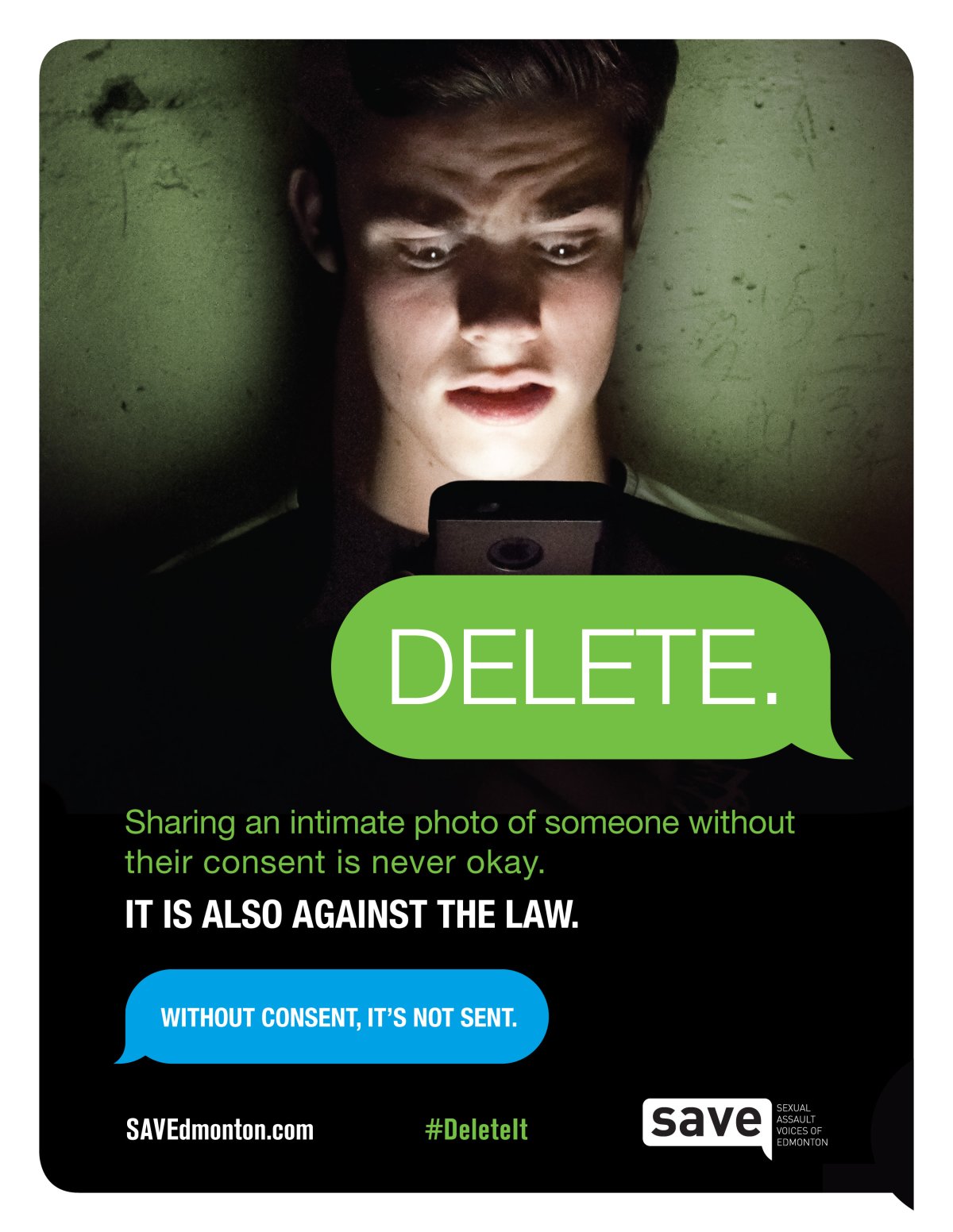EDMONTON — Friends send Snapchats. Lovers share suggestive selfies and sexts.

Technology has made it easier and easier to exchange videos and photos, but with it has come increased risk of those images falling into the wrong hands. It can cause bullying, sexual humiliation, black mail, and in some instances, suicide.
“Sharing an intimate photo of someone without their consent is never ok” is the message of a new campaign launched by an Edmonton organization.
The “Without consent, it’s not sent” campaign was launched Wednesday morning by Sexual Assault Voices of Edmonton, or SAVEdmonton.
“SAVE believes that non-consensual photo sharing is a serious form of sexual violence, and we want to challenge victim-blaming attitudes,” said SAVEdmonton Chair Dr. Cristina Stasia.
The campaign is aimed at kids in junior high, teens in high school and young adults. It features posters that will go up around the city, including all Edmonton public and catholic schools.
READ MORE: Sexting becoming more prevalent in Edmonton schools: police
“I think there’s a lot of young adults that actually don’t think about this. They just go ahead and send pictures, or they share them with their friends, not even thinking about the consequences or the impact,” said Edmonton police Staff Sgt. Shawna Grimes.
The anti-cyber bullying law Bill C-13 was passed earlier this year, making it illegal for anyone to share intimate photos of a person without their consent. Police say the legislation hasn’t stopped people from doing just that.
“At EPS, we’re also aware that these types of crimes are under reported, perhaps because of fear and embarrassment,” said Sgt. Grimes.
READ MORE: Why don’t women report rape? Because most get no justice when they do
SAVEdmonton created the campaign to provide non-victim blaming education that places the onus and responsibility on the person who is considering sharing a photo, instead of on the victim.
“We’re not out there to necessarily criminalize these young people,” said Sgt. Em Chan, a supervising officer with the EPS resource officer program that goes into city schools. “If we can remind them that it is against the law to make, to posess or to distribute these images, then that’s a wake-up call for a lot of them.”
16X9 INVESTIGATION: Coming forward in court – Women break their silence of sexual assault
Police say it’s also important for victims to feel supported.
“Reminding them something like this, a mistake young people make, it doesn’t define them. It doesn’t define who they are.”
SAVEdmonton also aims to provide support for victims after the fact. “Once it’s out there it’s very hard, you can report it, but it’s very hard to get that photo back. So we want to provide that education and some resources to help people deal with that,” said Dr. Cristina Stasia.
Just last week, the Alberta School Board Association voted in favour of asking the province to include consent as part of the sex ed curriculum in all Alberta schools.
Education Minister David Eggen says there is curriculum in grades four through nine that includes teaching around consent.
“Sexual consent is the law. Our expectation is that it should be taught in schools. There are resources available to support teachers on this important subject matter. We are planning to look at the teaching of sexual consent as part of a larger review of Alberta’s curriculum,” said Eggen.
Victim-blaming is a prevalent issue in society. Sexual humiliation and bullying is to blame for several high profile teen suicides, including that of Nova Scotia teen Rehtaeh Parsons and B.C. Teen Amanda Todd.
READ MORE: Death of Nova Scotia teen Rehtaeh Parsons draws comparisons to Amanda Todd case
Parsons was 17 when she took her life in 2013. She told her family she’d been raped by four boys in November 2011, then bullied for months after photos were distributed. Two men, who were minors at the time, were convicted of child pornography charges this year.
Amanda Todd was 15 when she killed herself in 2012. Before to her death, Todd posted a video on YouTube. In it, she used a series of flash cards to tell her experience of being blackmailed into exposing her breasts on webcam, bullied, and physically assaulted. The video went viral after her death.
READ MORE: International charges dropped against accused in Amanda Todd case
Sexual Assault Voices of Edmonton, or SAVEdmonton, is made up of the Edmonton Police Service, Responsible Hospitality Edmonton, the Sexual Assault Centre of Edmonton, the University of Alberta Sexual Assault Centre, and the Canadian Red Cross.
SAVEdmonton was also behind last year’s “Don’t be that Guy” campaign, which received international recognition.









Comments